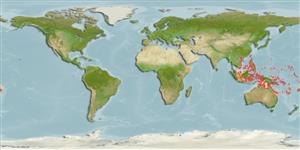Common names from other countries
>
Eupercaria/misc (Various families in series Eupercaria) >
Scaridae (Parrotfishes) > Scarinae
Etymology: Chlorurus: Greek, chloros = green + Greek oura = tail (Ref. 45335).
Environment: milieu / climate zone / depth range / distribution range
Ecologia
marino associati a barriera corallina; distribuzione batimetrica 0 - 35 m (Ref. 90102), usually 5 - 25 m (Ref. 9793). Tropical; 21°N - 25°S, 104°E - 174°W
Indo-Pacific: East Indian region to Micronesia, Samoa, and Fiji and Philippines to Australia; throughout East Indian region except Andaman Sea.
Size / Peso / Age
Maturity: Lm ? range ? - ? cm
Max length : 49.0 cm TL maschio/sesso non determinato; (Ref. 9710)
Short description
Chiavi di identificazione | Morfologia | Morfometria
Spine dorsali (totale) : 9; Raggi dorsali molli (totale) : 10; Spine anali: 3; Raggi anali molli: 9. This species is distinguished by the following characters: median predorsal scales 5-7 (usually 6); 2 scale rows on cheek, 1(6-8), 2(6-8); pectoral-fin rays 15; dental plates well exposed, lips not covering the plates; 1-2 conical teeth on side of upper dental plate; caudal fin truncate. Colour of initial phase (IP) dark brown with broad pale bars on sides and pale caudal fin and caudal peduncle; male with greenish large pale cream patch below eye bordered entirely by a thick green line. Male greenish with pink scale edges, green central zone and outer margins on tail and large rectangular whitish area on cheek; female dark brown with 3-4 broad pale bars (Ref. 9793, 90102, 117228).
Found in clear coastal and inner reefs (Ref. 48636); in lagoons and channel reefs (Ref. 2334). Feeds by scraping algae from the substrate (Ref. 26993). Females usually in small groups and maybe mixed with other species when feeding; males solitary nearby (Ref. 48636). Minimum depth reported taken from Ref. 128797.
Life cycle and mating behavior
Maturities | Riproduzione | Spawnings | Egg(s) | Fecundities | Larve
Oviparous, distinct pairing during breeding (Ref. 205).
Randall, J.E., G.R. Allen and R.C. Steene, 1990. Fishes of the Great Barrier Reef and Coral Sea. University of Hawaii Press, Honolulu, Hawaii. 506 p. (Ref. 2334)
IUCN Red List Status (Ref. 130435)
CITES (Ref. 128078)
Not Evaluated
Threat to humans
Harmless
Human uses
Pesca: scarso interesse commerciale; Acquario: Commerciale
Strumenti
Special reports
Download XML
Fonti Internet
Estimates based on models
Preferred temperature (Ref.
115969): 25.8 - 29.3, mean 28.6 (based on 1692 cells).
Phylogenetic diversity index (Ref.
82804): PD
50 = 0.5000 [Uniqueness, from 0.5 = low to 2.0 = high].
Bayesian length-weight: a=0.02754 (0.01419 - 0.05347), b=3.01 (2.83 - 3.19), in cm Total Length, based on LWR estimates for this species & (Sub)family-body (Ref.
93245).
Trophic level (Ref.
69278): 2.0 ±0.00 se; based on food items.
Resilienza (Ref.
120179): Medio, tempo minimo di raddoppiamento della popolazione 1.4 - 4.4 anni (Preliminary K or Fecundity.).
Fishing Vulnerability (Ref.
59153): Moderate vulnerability (39 of 100).
